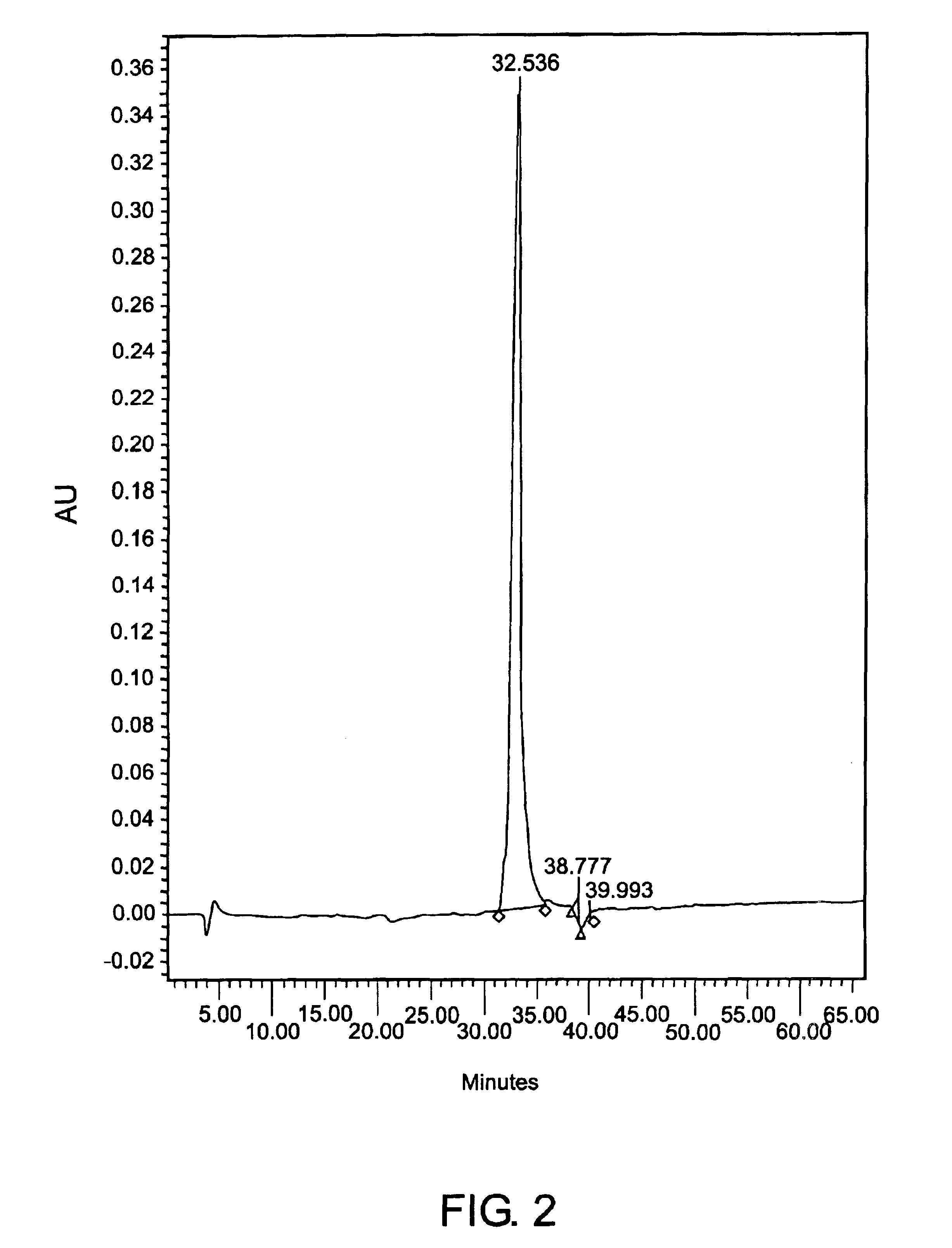Methods for purifying selected CEA family member proteins
a family member protein and purification method technology, applied in the direction of peptides, antibody medical ingredients, peptide sources, etc., can solve the problems of insufficient cancer screening markers, unfavorable cancer screening, and inability to identify cancer cells
- Summary
- Abstract
- Description
- Claims
- Application Information
AI Technical Summary
Benefits of technology
Problems solved by technology
Method used
Image
Examples
example 1
CEA Purification from Human Liver Tissue 1
[0150]30.6 g of lyophilized human liver tissue, including tumor tissue, were extracted for CEA at a neutral pH and the sample was brought to a concentration of 0.1M sodium chloride and adjusted to pH 3.0. The CEA containing sample was then applied to Fractogel EM SO3 cation exchange chromatography media equilibrated to pH 3.0 with 10 mM glycine and 0.1M sodium chloride, pH 3.0. The total protein of the sample was 29820 mg and the column volume was 1250 ml giving a load of 23.9 mg total protein per milliliter of packing material. The column was washed with the equilibration buffer to wash out all of the non-absorbed protein. The CEA was then eluted with a linear gradient to buffer B: 10 mM glycine, 0.5M sodium chloride, pH 3.0. The CEA eluted at about 0.25M sodium chloride, and the CEA content was determined using Bayer's ACS-180 analyzer.
[0151]The CEA-containing fraction was concentrated to 10-15 mg / ml total protein in a YM-30 stirred cell c...
example 2
CEA Purification from Pooled Cell Culture Harvests 1
[0152]Two CEA-containing human tumor cell lines, ATCC #CCL-253 and ATCC #CCL-248, were grown for four weeks. Spent media was then collected daily.
[0153]Cell culture spent media containing CEA from both cell lines was harvested, pooled, centrifuged, concentrated in a 30 kDa filter and dialyzed into a low conductivity neutral pH buffer. The sample was then injected onto the cation-exchange chromatography column and eluted as described above at a protein load of 20.8 mg / ml. The CEA was eluted at about 0.25M sodium chloride to a purity of approximately 2.5%.
[0154]The CEA-containing fractions were pooled and the sample was concentrated to 30 mg / ml total protein. As described above, the sample was injected onto a size-exclusion chromatography column and eluted at a purity of about 98% percent, as determined by reverse phase HPLC, as shown on FIG. 1. A single band appeared on SDS-PAGE.
example 3
CEA Purification from TriChem Resources Partially Purified CEA
[0155]Partially purified CEA, product #10695B (lot #01H0801FP) was received from TriChem Resources. The sample was centrifuged, concentrated using a 30 kDa hollow fiber cartridge, and injected onto the Superdex 200 SEC column. The fractions coming off the column were pooled, labeled A-G and assayed. The purity of the CEA did not meet requirements, therefore the B fraction was concentrated a second time and reprocessed by injecting it onto the SEC column again, to achieve a higher purity CEA. The sample still did not meet percent purity standards. All of the CEA that was eluted from the two SEC runs was pooled and injected onto the a CIX (Fractogel EM SO3 EMD SO3-650 M, product No. 16882-1, CIX from EM Science, Gibbstown, N.J.) containing CEC column. Fractions 8 and 9 were pooled to obtain 100% of the CEA injected onto the column. The purity was determined to be 100% by reverse phase HPLC. Contaminants were measured to be:...
PUM
| Property | Measurement | Unit |
|---|---|---|
| pH | aaaaa | aaaaa |
| pH | aaaaa | aaaaa |
| pH | aaaaa | aaaaa |
Abstract
Description
Claims
Application Information
 Login to View More
Login to View More - R&D
- Intellectual Property
- Life Sciences
- Materials
- Tech Scout
- Unparalleled Data Quality
- Higher Quality Content
- 60% Fewer Hallucinations
Browse by: Latest US Patents, China's latest patents, Technical Efficacy Thesaurus, Application Domain, Technology Topic, Popular Technical Reports.
© 2025 PatSnap. All rights reserved.Legal|Privacy policy|Modern Slavery Act Transparency Statement|Sitemap|About US| Contact US: help@patsnap.com



